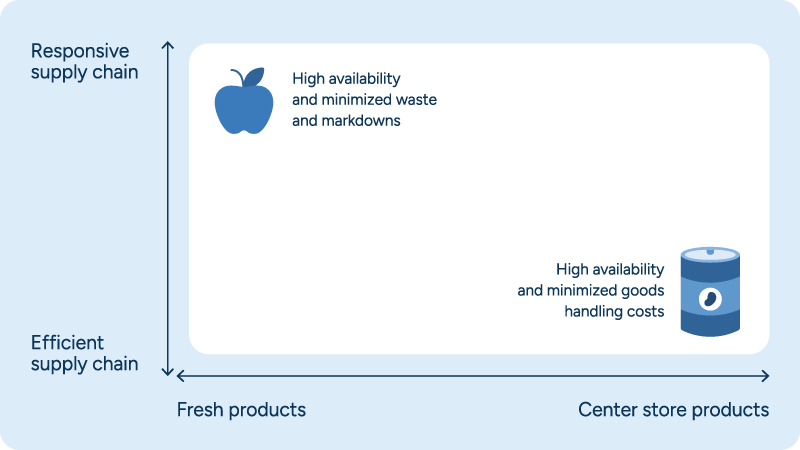8 grocery store inventory management good habits
Mar 12, 2024 • 8 min
One of the toughest challenges in retail is grocery store inventory management. Optimizing a broad inventory that includes both fresh and short shelf-life products can be daunting, but the good news is that solutions with AI and machine learning technologies can help simplify it. Working with grocery store inventory management software, retailers can make inventory management easy while positively impacting profitability.
Better replenishment of perishables means better-looking displays, fresher goods, and higher profit margins. Effective grocery store inventory management processes make the best use of product shelf-life information and category-level consumer behavior to cut retail food waste.
What is grocery store inventory management?
Grocery store inventory management (sometimes called supermarket inventory management) involves overseeing and controlling the ordering, storage, and use of products within a grocery store. It encompasses tracking inventory levels, managing stock replenishment, and ensuring that fresh, frozen, and center-store items are available to meet customer demand while minimizing waste and spoilage.
Unlike other types of inventory management, grocery store inventory management must account for the perishability of product. Planning and management teams require precise demand forecasting and stock rotation to maintain freshness.
Grocery stores also deal with a higher turnover of items and more frequent restocking compared to industries with longer product lifecycles. This complexity necessitates specialized tools and processes to handle the unique challenges of managing perishable goods efficiently.
READ MORE: A day in the life of grocery stores
8 grocery store inventory management good habits
For stores, fresh item management is a challenging task. Carry too few fresh items, and they can alienate their most loyal customers. Carry too many fresh goods, and the risk of grocery store food waste increases dramatically.
Mitigating these risks requires the adoption of good habits on the part of inventory planning and replenishment teams. The most essential waste-cutting and customer-pleasing management habits include:
1. Forecast accurately for optimal inventory levels
Accurate forecasting is crucial for effective grocery store inventory management as it helps to ensure that the right products are available in the right quantities at the right time. Having incorrect inventory data can affect other important aspects of the business, such as store performance, customer satisfaction, spoilage, and sales. Accurate forecasting enables grocery stores to optimize their inventory levels, reduce waste and spoilage, and minimize stockouts.
Stores can achieve accurate forecasting by using historical sales data, current inventory levels, and other relevant factors to predict future demand for each product. By clearly understanding demand patterns, grocery stores can adjust their ordering and replenishment processes to ensure that they have the right amount of inventory on hand to meet customer demand without overstocking or understocking. This ultimately leads to improved customer satisfaction, increased sales, and reduced costs associated with excess inventory and waste.
Mobile retail execution tools can synchronize with a retailer’s inventory software to provide a better understanding of inventory accuracy, enabling workers to promptly detect and address any inconsistencies between reported inventory data and the actual stock available.
READ MORE: Measuring forecast accuracy: The complete guide
2. Ensure a dynamic approach for both fresh and center store products
From fresh goods wholesalers to grocery retailers, from high-end to price-driven supermarkets, convenience stores to cash-and-carry chains, replenishment teams walk a thin line between spoilage costs and shelf presentation. This relationship makes it essential to get the balance right.
Grocers navigate a supply chain that serves both fresh and center store products with the same capacity constraints and resourcing costs while handling their different characteristics like code life and shelf space. For example, fresh products need a more just-in-time replenishment model. In contrast, center store items can be more cost-driven and space-aware. However, both should remain agile; otherwise, changes in demand will lead to lost sales.
Mission critical for grocery retailers is the ability to manage highly perishable goods with different spoilage rates down to the item level. Read more about the unique challenges in fresh management in our guide, The pillars of fresh success: How to increase efficiency and accuracy to battle complexity and waste.

Fig. 1: Grocery stores must take an approach to inventory management that balances the responsiveness required for fresh items and the efficiency needed for center store products.
3. Order inventory without overlooking product-level shelf life
All major retailers have contracts with suppliers that specify that items have an agreed minimum shelf life when delivered. However, this information isn’t always given enough importance in replenishment, as sell-by dates vary. These variables, however, can often be worked into forecasts.
Retailers need a model to estimate the two main cost components in grocery retail business — spoilage and lost sales — in all possible real-life situations. Based on these two estimates, a cost function is formulated to lay out the total cost of ordering. By understanding the trade-offs, an intelligent system can balance the costs between spoilage and lost sales in various situations. This process minimizes costs by varying the safety stock level and choosing the value, resulting in minimal total costs.
Even though most orders can be done with optimization alone, the final tuning often benefits from smart heuristics. The simplest step to take is for retailers to incorporate shelf-life expectations into their supermarket inventory management system’s ordering parameters.
For example, the set parameters can tie safety stock calculations to a max “x%” of the expected shelf life forecast or be used to build exception reports when safety stocks are likely to creep over a set threshold. Meanwhile, setting exceptions for when a case pack’s days of supply exceed “y%” of shelf life can help highlight products needing close supervision.
Develop stronger collaborative relationships with suppliers to ensure timely deliveries, negotiate better terms, and collaborate on inventory management strategies. This helps maintain optimal inventory levels and reduce costs associated with stockouts and overstocking.
4. Incorporate forecasted spoilage — with help from simulations
Spoilage forecasts are helpful in order parameter calculation, but good systems can also use them in replenishment calculations by factoring in future spoilage. In DC environments, teams usually introduce batch-level inventory balances with sell-by-date information. This data helps keep availability high by replenishing before stock spoils and flagging items that need to be sold quickly.
Better replenishment of perishables means your displays look better, customers get fresher goods, and you sell more.
This is tricker in retail environments, as consumers don’t always operate on the “first-in-first-out” principle. They want items that appear the freshest, regardless of how long the item has been on display. Luckily, modern replenishment tools can estimate consumer shopping behavior and generate estimates for batch balances. Systems can utilize accurate simulated spoilage figures in replenishment calculations to keep availability optimal even for low-volume products.
READ MORE: How to improve fresh food inventory management with unified central planning and store execution
5. Manage each product individually – but understand how products behave in groups
In many perishable categories, products often substitute so readily for one another that the consumer can switch without a second thought. Fresh bread is a good example. RELEX began optimizing bread replenishment with one client by identifying “must-haves” in each sub-category via store-level ABC classification.
RELEX ran replenishment with the belief that “nice-to-have” products could run out towards the end of the evening, but there should always be stock in all basic categories (e.g., sliced white, whole grain, seeded). The optimization had the expected impact on food waste, but it was surprising how much category sales and sales margins also increased (over ten percentage points on average). Because of better inventory turnover, fresher products simply appeal more to consumers.
6. Dive into your day-level data
In retail, significant gains come from small improvements across countless SKU-store combinations. To get the big figures right, however, you must master your low-level data. One example is from a department store known for its high-end food halls. When managers followed up on an exception alert, they discovered unacceptable levels of spoilage from their fresh meat counters.
An analysis of store-level data suggested that the problem only affected smaller, out-of-town stores. Drilling further into the data to the SKU-store level pinpointed the culprits — a small number of more expensive products like Beef Wellington. Further analysis of daily sales forecasts and delivery schedules showed that sales were primarily on Friday and Saturday — as these premium meat products would be the centerpiece of a weekend family meal.
Since deliveries were typically on Mondays and sales from Monday to Thursday were low, most of the deliveries would end up being thrown away. The store chain simply reduced the selection of expensive products available Monday to Thursday to address the problem. It helped that they had a solution in place that gave them instant results and thus complete transparency.
In retail, big gains come from small improvements across countless SKU-Store combinations. To get the big figures right, you must master your low-level data.
Good data is essential for effective inventory management in grocery stores, especially since it is such a complex environment, but the data alone is not enough. All the data in the world is of no help if you cannot access it and easily make sense of it.
READ MORE: How data best practices can improve inventory management and forecast accuracy
7. Adopt optimized cycle counting
Accurate inventory records are essential to successful inventory management. Optimized cycle counting is designed to meet the specific needs of grocery retail, enhancing stock level accuracy through strategically scheduled counts. Teams plan the counts based on each product’s turnover and historical sales data, allowing for regular and focused reviews of high-priority items. This proactive approach significantly reduces inventory discrepancies and shrinkage.
The effectiveness of this method hinges on sophisticated software — specifically, a tool that precisely calculates the optimal frequency for counting each product category and automates the scheduling of these counts. Such analytical capabilities can provide crucial insights that inform smarter replenishment strategies to ensure inventory levels consistently synchronize with consumer demand.
The result: a boost in operational efficiency, a reduction in waste, and an increase in profitability.
READ MORE: How to optimize cycle counting and banish phantom inventory
8. Improve grocery store inventory management software KPIs
Technology can be crucial in improving fresh inventory management and helping retailers deal with seasonal inventory by providing more accurate forecasting, automating ordering, and replenishment. It can also provide up-to-date visibility into inventory levels and product movement.
Advanced forecasting algorithms can help predict demand for fresh products more accurately, considering factors such as seasonality, weather, and promotions. Forecasting solutions can help retailers optimize their inventory levels and reduce waste due to spoilage.
Grocery store inventory management software can also help automate the ordering and replenishment process for fresh products, ensuring that the right products are ordered at the right time and in the right quantities. This can help reduce stock-outs and overstocks, leading to lost sales and increased waste.
Improve your grocery store inventory management with RELEX
RELEX provides near-real-time visibility into inventory levels and product movement, allowing retailers to quickly identify and address any issues that arise. This visibility can help improve the overall efficiency of the supply chain and reduce the risk of waste due to expired or unsellable products.
RELEX grocery inventory management software gives grocers the power to handle big data, granularize it however they choose with the most up-to-date data to deliver results quickly. RELEX helps grocery stores manage their inventory planning to make the best use of products’ shelf-life information and category-level consumer behavior to cut food waste.



